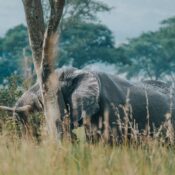African Elephants Facts
African Elephants Facts

African Elephants
The African Elephant has two confirmed species the Bush elephant Loxodonta africana and the Forest elephant Loxodonta cyclotis, both of which exist in Uganda. The forest elephant is mainly found in Kibale National Park.
The elephant is the largest terrestrial mammal on earth. Elephants exhibit complex intelligence, social behavior, and play a key role in the wild ecosystems.
Despite their important roles in maintaining ecological balances and the flow of tourism income to the range states, the African elephant remains one of the top most species faced with high risk of extinction.
Globally, the elephant is classified as vulnerable by the IUCN. As a result of the high levels of commercial poaching largely attributed to illegal trade in ivory and its products, the elephant population is facing substantial pressure.
This is exacerbated by habitat degradation and loss mainly due to land use changes driven by an increased human population in the region.
Elephants are vital to the web of life in Africa. As a keystone species in habitat modification, elephants play important roles in providing balanced conditions for all the other species to survive within their ecosystem.
Opening up forest habitats to create firebreaks and grasslands, creation of water pools for other wildlife, and leaving nutrients along their way required for the growth of flora and certain faunal species.
Sometimes called the “gardeners”, elephants are essential for the dispersal of seeds that maintain tree diversity (

African Elephants
[2014] in the wild. Despite all this, the contributions of elephants on ecosystem enhancement remain only partially understood. (Ssali et al. 2012).
In the past, elephants had an extensive range of habitats, traversing across the country through migration corridors.
However, the current increase in human population, coupled with the demand for arable land and settlement, has reduced the suitable habitat range for elephants in Uganda.
This trend has contributed to the fragmentation of elephant habitats and affected their natural migratory pattern and dispersal behaviors.
At the moment, the largest populations of elephants in Uganda are found in Queen Elizabeth National Park (2913), other Protected Areas with elephants are Murchison Falls National Park (1330), Kidepo Valley National Park (407) and Kibale National Park (487) with few individuals found in Bwindi Impenetrable National Park,
Rwenzori Mountains National Park, Toro Semliki Wildlife Reserve, Katonga Wildlife Reserve, Budongo Forest Reserve outside Murchison Falls Protected Area, Karenga Community Wildlife Area, Otze/ Dufile, Aswa Lolim and East Madi Wildlife Reserve.
Elephants have also been sighted in Sango bay and are believed to be migrating and using habitats across the common international border of Uganda and Tanzania in search for water and forage.
Since the late 1980s, there has been a gradual increase in elephant population in the key elephant Protected Areas of Queen Elizabeth National Park, Murchison Falls National Park and Kidepo Valley National Park.
The elephant population in wildlife protected areas is currently estimated at 5,564 but this could be higher if elephant surveys in remnant forested areas outside national parks and wildlife reserves are undertaken.

African Elephants
for more information visit
All Categories
Recent Posts
Kidepo Valley National Park
The Kabaka’s lake
What is the African elephant?
Tags
Quick booking process
+256 393254072


